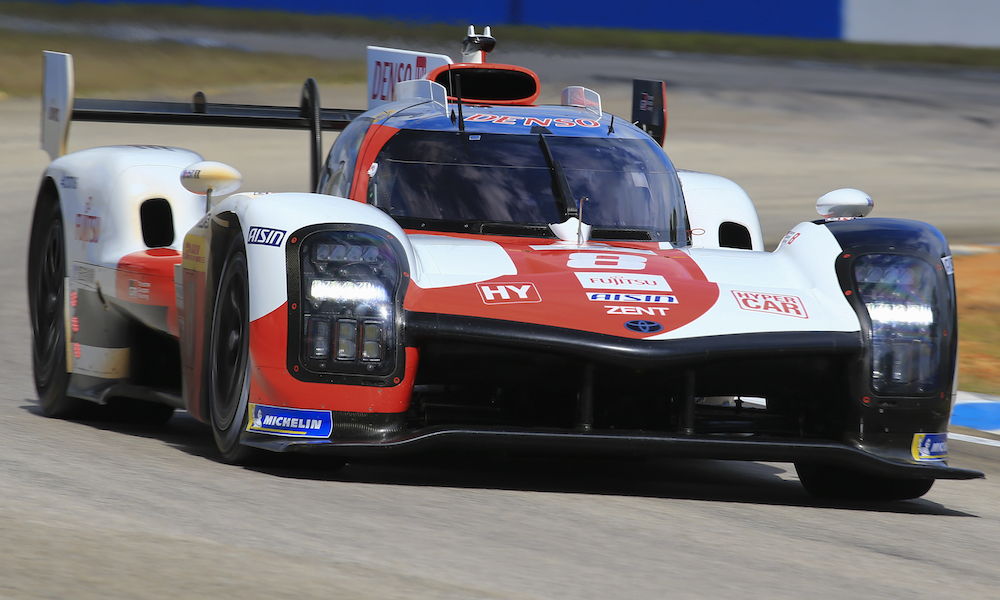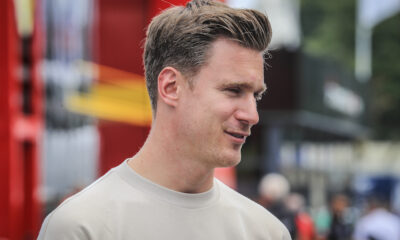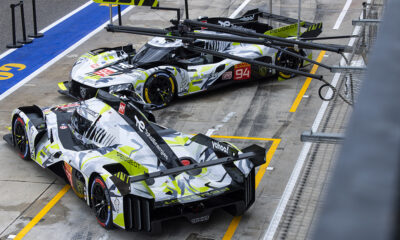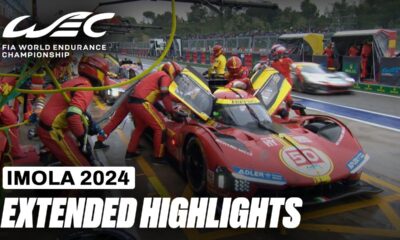Toyota Gazoo Racing’s drivers are adapting to the “big challenge” of having a higher hybrid deployment speed at Sebring for the opening round of the FIA World Endurance Championship.
Both Toyota GR010 Hybrids are starting the new season with a Balance of Performance that requires their front-mounted electric motor to kick in at 190 km/h, which is 70 km/h more than the dry weather activation point for the whole of last season.
Drivers Sebastien Buemi, Jose Maria Lopez and Kamui Kobayashi each described how the increase in hybrid deployment speed is impacting their experiences behind the wheel.
All three suggested that the benefit of four-wheel-drive power brought on by activation of the 200 kW hybrid system is only felt through one corner on the 3.74-mile lap.
“You use [four-wheel-drive] on the straight but there are no other corners that are faster than 190, other than Turn 1,” Buemi told Sportscar365.
“The four-wheel-drive helps you with traction. The problem is, at 190 you are not limited by the grip. You are limited by the power. To make it simple, you cannot wheel spin anymore at 190.
“So you don’t get an advantage of having the four-wheel-drive. You get it a bit in Turn 1 to stabilize the car because you don’t go below 190, but other than that not really.
“We topped a [Prologue] session once when we had new tires. When you look at the BoP you clearly see that we’ve been slowed down massively. It was a very big hit.
“Now it is the way it is, and we will try to do our best. Unfortunately, I’m not convinced we’re going to be able to fight for the win, but we do what we can.”
Lopez added: “You’re sliding much more driving the car. It is a car designed through the years: you have the technology from the LMP1 [era] as well, the front-wheel-drive.
“We have done a lot of development around where we were supposed to deploy the speed, which was 120 km/h. So definitely it’s a challenge for the engineers.
“The traction control used to work differently: now it’s only relying on the rear. There are a lot of things and it’s been a big challenge.”
Kobayashi described last weekend’s Prologue test as a “hard time” for Toyota as it ranked behind LMP2 cars in the timing charts in three of the four sessions.
The opening Free Practice of race week saw the No. 8 Toyota finish third, behind the Hypercar entries from Glickenhaus and Alpine, while the No. 7 ended up fifth.
In addition to the higher hybrid deployment speed, the Toyotas have a lower maximum per stint energy allowance for Sebring and a higher minimum weight of 1070 kg.
That is 30 kg more than what they had for the 2021 season finale in Bahrain and 4 kg more than what they had for last year’s 24 Hours of Le Mans, which was the last time that the Glickenhaus 007 Pipo was included in the BoP.
“The problem is that we designed the car with four-wheel drive,” said Kobayashi. “Now we cannot use for most of the corners with four-wheel-drive. We have no advantage at all.
“Now we just carry the weight. At the end of the day we’re not quickest in the cornering because when you see our weight, it’s nearly impossible to have any benefits.
“This is the BoP at the end of the day. For me there are surprises: LMP2 looks pretty fast.”
Although the quickest LMP2 cars led the Prologue and were strong in the early Free Practice running, the chances of an LMP2 overall win at Sebring are low since the category’s 2022 rules mandate a smaller 65-liter fuel tank that will require more pit stops.
It has been estimated that the LMP2s will run stints of around 20 or 21 laps during Friday’s eight-hour race, with the Toyotas expected to be in the higher 20s.
Reigning LMP2 champion Charles Milesi, who drives for Richard Mille Racing, suggested that the adapted Oreca does not feel like a huge departure from last year but believes that the Hypercars will have no trouble beating his class in qualifying and the race.
“I think in the race it will be different,” he told Sportscar365.
“We have less fuel so we will make more stops. So for the first stint it may be close, but I’m not concerned about the difference in qualifying.
“Maybe it will be two seconds or something. I think [the close times] is a Prologue thing. The same thing happened at Spa last year: in qualifying they were seconds faster than us.”
Lopez shared Milesi’s sentiments regarding the class separation, known as stratification, but suggested there could be occasions when the two classes interact closely.
“In the general classification, they can’t fight,” he said. “But if we are together, and we are on cold tires and they are on warm tires, it is going to be a pain for them, and vice versa. Because for us it is very difficult to pass now: the top speed is not great.
“Out of the corners they are quicker. It’s not easy. You find yourself sometimes taking risks if you really want to overtake.”
As his drivers adapt to a higher hybrid deployment speed, Toyota’s WEC technical director Pascal Vasselon added that Sebring is inherently not an optimal track for LMH machinery.
“Clearly this kind of circuit, like Portimao, is a place where the very different performance profiles of LMP2 and our cars hit us at the maximum,” Vasselon said.
“It’s a high-downforce circuit with very few straight lines and a lot of corners. LMH cars are fast in a straight line and not so much in corners.”
Davey Euwema contributed to this report























